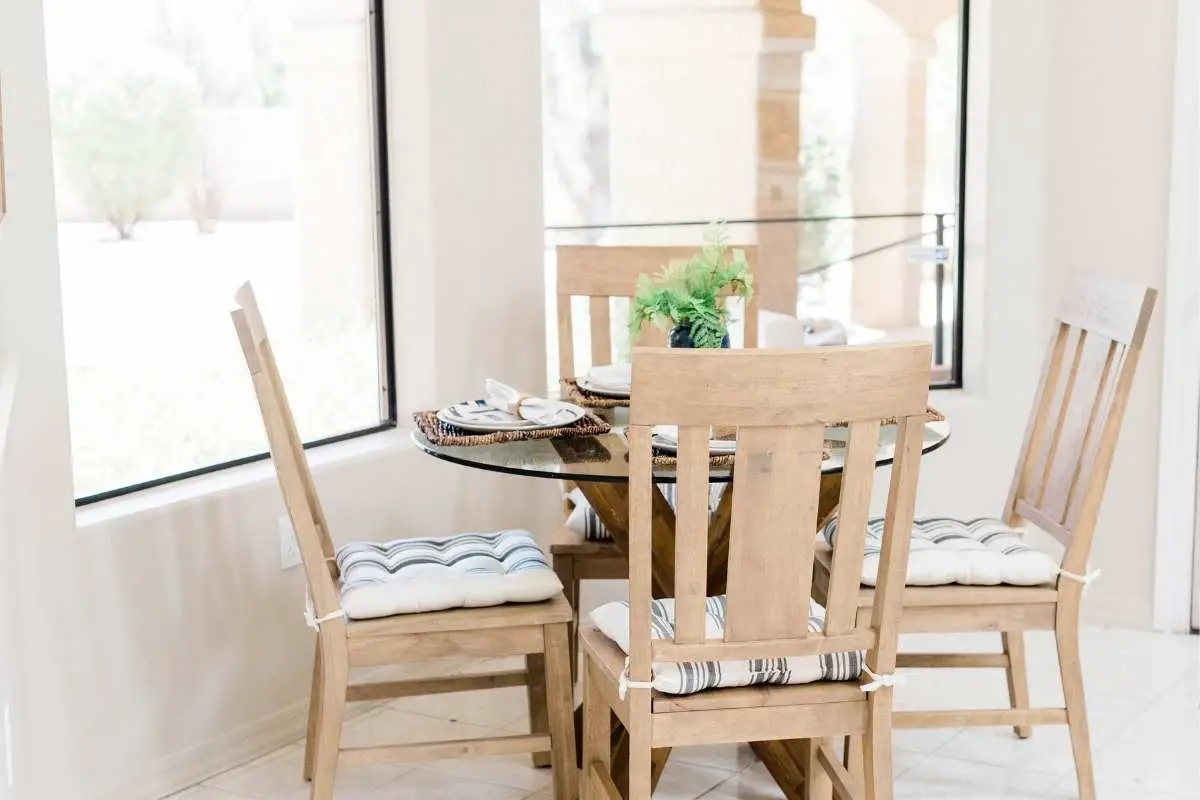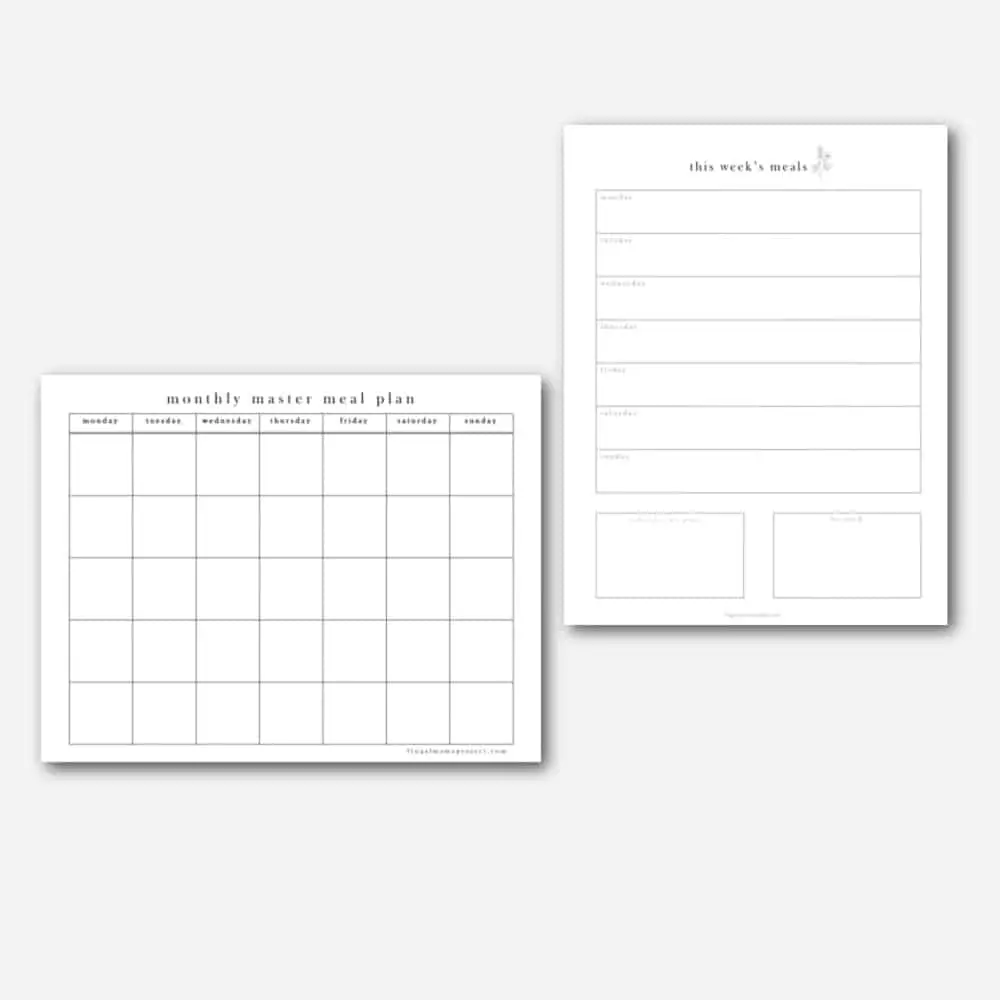Every afternoon, the sun starts to go down, and so do your spirits. It’s almost dinnertime. Again.
You think you have something you can make. There’s a chicken in the freezer, and there might be time to defrost it. And you know you have a recipe you saw a few weeks ago you wanted to try. But you’re missing a few ingredients, and maybe that wasn’t even the recipe you liked. Yikes. You search online more and then wonder if this chicken will even thaw in time. Instead, you send your husband a text: Can you pick up a pizza on your way home? It was crazy here today
No one really likes meal planning. But the only thing worse than meal planning is not meal planning. It leads to the weird, panicky scenario above where you’re dreading dinner and can’t think of a single thing to make, much less something that you actually have the ingredients for.
Don’t worry. This simple meal planning system walks you through the easiest way to make a plan you will really stick to. No complicated charts and rules to follow and just enough structure. You will not fail with this method.
1. Create a simple, functional recipe binder
Saving recipes online in different places is too hard to organize or easily access. So print your favorite and put them into a simple recipe binder.
This works because a compact binder is easy to use and perfect for actually cooking. It lays flat, keeps everything in page protectors, and allows you to find everything without wasting time looking for it online.
It should only include family favorites. A recipe needs to earn its spot in your binder.
What you’ll need to make this work:
- A 3-ring binder (not the cheapest kind, but there’s no need to spend a lot)
- Page protectors
- Divders
- Access to a printer or willingness to copy recipes by hand
You don’t need a pretty recipe binder, just a functional one.
If you want to save new recipes that you haven’t tried yet, that’s fine. They can go in their own section. Do not mix them up with your tried and true recipes that have made it into your rotation. The idea is to be able to open your binder and start cooking, not sift through a hundred things you’ll never make.
For now, don’t worry about categorizing. Just get them printed, in page protectors, and a binder. Photocopy favorites out of a cookbook and print out your online favorites.
Tuck the binder away for now and move on to step two of our meal planning system.
2. Theme nights, but better (let your schedule be your guide)
Now we need to make what I call a “skeleton plan.” Print out a blank, undated calendar. (Click here and grab some simple meal planning printables to help you.) We’re going to think about what is going on in our life before we plan meals.
Most people have commitments like sports practices, nights their husbands work late, or other things that make dinner challenging.
Think of your craziest night of the week, the one where not having to make dinner would be a big gift to yourself. That night, from now on, is leftover night. If leftover night rolls around and you don’t have enough to eat, you can serve cereal or sandwiches. That’s it. (As a bonus, this helps you avoid food waste and saves you money.)
If you have more than one busy night, that’s okay. You don’t have to eat leftovers all the time. Designate them as “easy meal nights.” You’ll serve a freezer meal, a slow cooker meal, or something from the instant pot on these nights.
Go through your recipe binder and pull out all the meals suitable for an “easy night.” They should require a half hour or less of prep time. Put them in their own divider section
⭐️ Related: How to Save Money by Avoiding Food Waste at Home
3. If you like restaurants or takeout, plan for them

Getting takeout is NOT a failure! It’s a good meal, and you’re allowed to enjoy it. You don’t have to cook every meal! If this is something your family enjoys, there’s no need to feel guilty.
Go back to your skeleton plan and schedule one night a week (or more, depending on your budget!) to be a night you buy dinner. Print out menus from your favorite places and put them in page protectors in your binder. This way, if you know you’ll be getting pizza on Saturday, you won’t plan for homemade pizza on Sunday.
Of course, you are allowed to incorporate restaurants into your weekly menu. Planning like this makes takeout part of your system and removes the guilt. You can also enjoy the feeling of not having to worry about dinner all day. Everyone needs a break.
4. Don’t overestimate your motivation
If you plan an elaborate meal from scratch every night, you’ve set yourself up to fail.
So far, we’ve focused on quick and easy meals and how to deal with busy days. But if you love cooking, it’s important to schedule time for things that take longer to cook.
I’m not suggesting that you spend all day in the kitchen, but meal planning systems fail when they are impersonal. So if you love cooking, make sure your meal plan allows for it.
The key to keeping this enjoyable? Make sure you alternate quick and easy meals with more complicated ones. This way, you get to enjoy mealtime and still keep yourself from burning out.
Go back to your skeleton meal plan and pick out 2-4 days per month that you’d like to spend a little more time in the kitchen. Find some of your favorite recipes that take a little longer, and put them in a new section of your binder.
5. Fill out the rest of your monthly plan with favorites, new and old
The remaining days of your plan are the days you will make your family favorites. It’s likely you already have recipes memorized for some of these, but if not, print them on recipe cards and put them in your binder. (If you do have them memorized, just make a list of them.)
Take a look at what meal ideas you like to make more than once or twice a month. Most families have “tiers” of favorites. Some you can happily cook once a week, some are more once a month. Some might be just a few times a year, but you still like them.
Only you know the best way to schedule these in your skeleton plan. We have one recipe that’s cooked once a week and a few that are every other week.
Fill out the rest of your plan with “favorite” nights or “other nights.” Do whatever makes sense to you.
6. Make one monthly meal plan that you love
We have our skeleton plan, filled with theme nights. We have our recipe binder sorted by these categories. So this step is easy.
Pick out recipes that correspond to each theme and fill out your menu. This shouldn’t take long!
As you work, consider a few things:
Do you have a picky eater or allergies in your household that require an alternate meal?
Are any of these recipes seasonal? Can you plan an alternate for the opposite season? (For example: make chili in the winter and hot dogs in the summer.)
Now that you have a beautiful monthly meal plan that works for you. And you can repeat it. Forever and ever. Amen.
7. Weekly meal plans still have a place
Now, don’t be mad. You still should create a weekly plan every Sunday evening. But with your new system, it will take just a few minutes and absolutely no mental energy.
The purpose of this weekly final draft? Well, there are a few:
- It gives you a set time to check your pantry and fridge to see what ingredients you have
- At this time, you should make your grocery list to fill in anything you’ll need. We’re trying to minimize grocery shopping, so make sure you have a week’s worth of snacks, breakfasts, and everything else you’ll need.
- Some weeks will have weird stuff going on. Will there be anything else happening that week? Maybe a birthday party, an event at school, or something else? Does it change your menu planning?
- It lets the whole family know exactly what is coming up at dinner time. (Put a paper copy up in a prominent place to avoid questions and opinions. Click here to grab one free.)
- Weekly meal plans work for a reason. A week is the perfect amount of time to do grocery shopping and planning without things changing too much.
Grab your free meal planning system printables here to make things even easier
Just click HERE or on the image for an instant download.

Wait, what about breakfast, lunch, and snacks?!
Easy! Have five to ten lunch and breakfast recipes and write them down somewhere. They should all be pantry meals. Don’t make anything else. (Except for serving leftovers to avoid wasted food.)
Want to take your meal planning to the next level?
You don’t have to repeat your monthly meal plan forever. (Although it is a lovely, streamlined system.)
Now that you have a new meal planning system in place, your life should dramatically improve. This might sound dramatic, but it isn’t. Any given week, the average mom wastes hours worrying about dinner, looking for recipes, and making last-minute trips to the grocery store.
Meal planning solves these problems. And a simple, repeatable system solves the problem of meal planning itself (that it is hard and boring!). Now that we’ve made meal planning easier, we’ve made your life easier.
I hope you go beyond just reading this and actually do it.
Have a great week of delicious meals, and more importantly, no more wondering what to make for dinner. I’m rooting for you!

